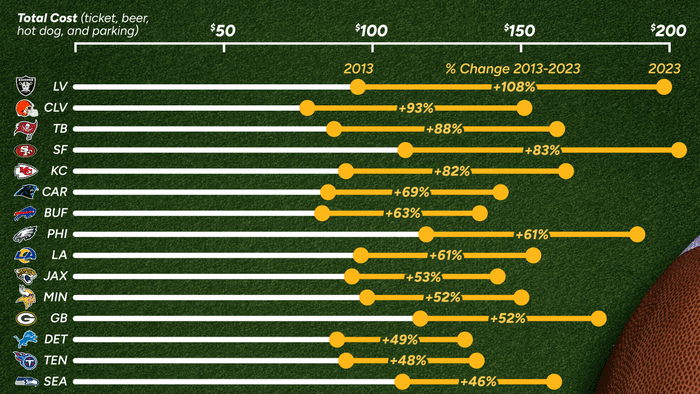Attending an NFL game has increasingly become a luxury experience, with significant ramifications for fans and the broader sports culture. In 2023, the average ticket price reached $120, marking an increase of 8.6% within a single year. This price surge is primarily driven by the advent of new stadium constructions that emphasize luxury amenities. Newer stadiums are designed with fewer seats, accommodating more luxury boxes and premium seating options, thereby driving up the overall costs. For instance, Allegiant Stadium, which hosted the 2022 Super Bowl in Las Vegas, has a seating capacity of only 65,000, one of the smallest in the league. This trend underscores a shift in how NFL games are marketed and experienced, prioritizing lucrative options that significantly alter the typical fan experience.
Examining the broader context, data reveals that NFL game costs have escalated by 39% over the past decade, outpacing inflation. An analysis of various factors, including ticket pricing, parking, beverages, and food, indicates that fans are now paying significantly more than they were in 2013. The Las Vegas Raiders stand out with the steepest increases, as attending a game has become $103 more expensive compared to a decade ago, attributed to the cost of their newly constructed Allegiant Stadium, which ran an astonishing $1.9 billion. This stark rise in expense is echoed across multiple teams, indicating a pervasive trend within the league.
The Kansas City Chiefs exemplify how on-field success affects ticket prices; their recent Super Bowl victories have seen ticket costs soar by 103% in the last ten years. In 2023, the resale market for Chiefs tickets reflected this premium standing, with average home game tickets commanding around $468—making them among the highest in the league. This phenomenon highlights the correlation between team performance, desirability, and the subsequent financial implications for fans eager to witness their teams live. Conversely, teams like the Dallas Cowboys, despite being recognized as the most valuable sports franchise globally, have managed to keep their ticket prices relatively stable.
Interestingly, the Dallas Cowboys have experienced a mere 1% decline in game attendance costs since 2013, despite previously leading the league in pricing. The current average cost for a Cowboys game sits at $160, which is slightly above the NFL average but significantly lower than the sheer rise witnessed by teams like the Chiefs and Raiders. This anomaly suggests that even in a league where ticket prices are spiking, some franchises can maintain a more stable pricing strategy, appealing to a broader audience without alienating fans with exorbitant costs.
In a similar vein, the New York Jets and New England Patriots have also shown relatively modest price hikes over the past decade. These teams, despite their historic rivalries and prominent market share, have kept to slower growth in ticket pricing. However, the overall trajectory within the NFL paints a picture of a league increasingly catering to affluent fans, thereby potentially excluding a dedicated segment of its traditional fanbase. The rising costs necessitate a reconsideration of what it means to support a team and how access to live games may be perceived in the future.
Ultimately, as the landscape of NFL attendance continues to evolve, it raises important questions about equity, accessibility, and the future of fan engagement in professional sports. The trend toward premium seating and luxurious amenities may enhance profits for franchises but poses a significant barrier to the average fan wishing to partake in the experience of attending a live game. As ticket prices and associated costs continue to rise, the NFL must navigate how to balance the demand for luxury with the desire to maintain a loyal and diverse fanbase, ensuring that the excitement of game day remains accessible to all.

